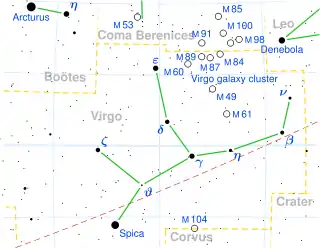Phi Virginis
Phi Virginis (φ Virginis, abbreviated Phi Vir, φ Vir) is a binary star[7] in the zodiac constellation of Virgo. It can be seen with the naked eye, having an apparent visual magnitude of +4.81.[2] Based upon parallax measurements obtained during the Hipparcos mission, it is located roughly 118 light-years (36 parsecs) distant from the Sun.[1]
 | |
| Observation data Epoch J2000 Equinox J2000 | |
|---|---|
| Constellation | Virgo |
| Right ascension | 14h 28m 12.13894s[1] |
| Declination | −02° 13′ 40.6579″[1] |
| Apparent magnitude (V) | +4.81[2] |
| Characteristics | |
| Spectral type | G2 IV[2] |
| B−V color index | +0.683[3] |
| Astrometry | |
| Radial velocity (Rv) | −9.88±0.15[3] km/s |
| Proper motion (μ) | RA: −139.53[1] mas/yr Dec.: −4.04[1] mas/yr |
| Parallax (π) | 27.58 ± 1.01[1] mas |
| Distance | 118 ± 4 ly (36 ± 1 pc) |
| Absolute magnitude (MV) | 1.68[4] |
| Details[3] | |
| Mass | 1.80[5] M☉ |
| Radius | 4 R☉ |
| Luminosity | 12.6 L☉ |
| Surface gravity (log g) | 3.4 cgs |
| Temperature | 5,534 K |
| Metallicity [Fe/H] | −0.06 dex |
| Rotational velocity (v sin i) | 15.5 km/s |
| Age | 1.5[5] Gyr |
| Other designations | |
| Database references | |
| SIMBAD | data |
The two components are designated Phi Virginis A (officially named Elgafar /ˈɛlɡəfɑːr/, the traditional name for the system)[8] and B.
Nomenclature
φ Virginis (Latinised to Phi Virginis) is the binary's Bayer designation. The designations of the two components as Phi Virginis A and B derive from the convention used by the Washington Multiplicity Catalog (WMC) for multiple star systems, and adopted by the International Astronomical Union (IAU).[9]
Ideler described an Arabic lunar mansion "El-ġafr" (Arabic الغفر al-ghafr) for the stars Phi, Iota and Kappa Virginis.[10] In 2016, the IAU organized a Working Group on Star Names (WGSN)[11] to catalog and standardize proper names for stars. The WGSN decided to attribute proper names to individual stars rather than entire multiple systems.[12] It approved the name Elgafar for the component Phi Virginis A on 1 June 2018 and it is now so included in the List of IAU-approved Star Names.[8]
In Chinese, 亢宿 (Kàng Xiù), meaning Neck, refers to an asterism consisting of Phi Virginis, Kappa Virginis, Iota Virginis, and Lambda Virginis.[13] Consequently, Phi Virginis itself is known as 亢宿三 (Wěi Xiù sān), "the Third Star of Neck".[14]
Properties
The primary component, Phi Virginis A, has a stellar classification of G2 IV,[2] indicating that it is a G-type subgiant which is evolving away from the main sequence. It is slightly variable with an amplitude of 0m.06.[15] The star has about 1.8 times the mass of the Sun,[5] 4 times the Sun's radius, and shines with 12.6 times the luminosity of the Sun.[3] It is around 1.5[5] billion years old and is spinning with a projected rotational velocity of 15.5 km/s. The effective temperature of the star's outer atmosphere is 5,534 K.[3]
The secondary, Phi Virginis B, is a magnitude 9.10 companion at an angular separation of 5.160 arcseconds.[7] A second visual companion lies at an angular separation of 91.40 arcseconds along a position angle of 202°, as of 2000.[16]
The system is a source of X-ray emission with a luminosity of 2.158×1020 erg/s.[17]
References
- van Leeuwen, F. (November 2007), "Validation of the new Hipparcos reduction", Astronomy and Astrophysics, 474 (2): 653–664, arXiv:0708.1752, Bibcode:2007A&A...474..653V, doi:10.1051/0004-6361:20078357.
- Gray, R. O.; et al. (2001), "The Physical Basis of Luminosity Classification in the Late A-, F-, and Early G-Type Stars. I. Precise Spectral Types for 372 Stars", The Astronomical Journal, 121 (4): 2148–2158, Bibcode:2001AJ....121.2148G, doi:10.1086/319956.
- Massarotti, Alessandro; et al. (January 2008), "Rotational and radial velocities for a sample of 761 HIPPARCOS giants and the role of binarity", The Astronomical Journal, 135 (1): 209–231, Bibcode:2008AJ....135..209M, doi:10.1088/0004-6256/135/1/209.
- Schiavon, Ricardo P. (July 2007), "Population Synthesis in the Blue. IV. Accurate Model Predictions for Lick Indices and UBV Colors in Single Stellar Populations", The Astrophysical Journal Supplement Series, 171 (1): 146–205, arXiv:astro-ph/0611464, Bibcode:2007ApJS..171..146S, doi:10.1086/511753.
- Mallik, Sushma V.; Parthasarathy, M.; Pati, A. K. (October 2003), "Lithium and rotation in F and G dwarfs and subgiants", Astronomy and Astrophysics, 409 (1): 251–261, Bibcode:2003A&A...409..251M, doi:10.1051/0004-6361:20031084.
- "* phi Vir". SIMBAD. Centre de données astronomiques de Strasbourg. Retrieved 2016-09-18.
- Eggleton, P. P.; Tokovinin, A. A. (September 2008), "A catalogue of multiplicity among bright stellar systems", Monthly Notices of the Royal Astronomical Society, 389 (2): 869–879, arXiv:0806.2878, Bibcode:2008MNRAS.389..869E, doi:10.1111/j.1365-2966.2008.13596.x.
- "Naming Stars". IAU.org. Retrieved 18 June 2018.
- Hessman, F. V.; Dhillon, V. S.; Winget, D. E.; Schreiber, M. R.; Horne, K.; Marsh, T. R.; Guenther, E.; Schwope, A.; Heber, U. (2010). "On the naming convention used for multiple star systems and extrasolar planets". arXiv:1012.0707 [astro-ph.SR].
- Ideler, Ludwig (1809). Untersuchungen über den Ursprung und die Bedentung der Sternnamen. J. F. Weiss.
- "IAU Working Group on Star Names (WGSN)". Retrieved 22 May 2016.
- "WG Triennial Report (2015-2018) - Star Names" (PDF). p. 5. Retrieved 2018-07-14.
- (in Chinese) 中國星座神話, written by 陳久金. Published by 台灣書房出版有限公司, 2005, ISBN 978-986-7332-25-7.
- (in Chinese) 香港太空館 - 研究資源 - 亮星中英對照表 Archived 2008-10-25 at the Wayback Machine, Hong Kong Space Museum. Accessed on line November 23, 2010.
- Adelman, S. J.; et al. (December 2000), "On the Variability of G0-G9 Stars", Information Bulletin on Variable Stars, 4993: 1, Bibcode:2000IBVS.4993....1A.
- Mason, B. D.; et al. (2014), "The Washington Visual Double Star Catalog", The Astronomical Journal, 122: 3466–3471, Bibcode:2001AJ....122.3466M, doi:10.1086/323920, retrieved 2015-07-22.
- Makarov, Valeri V. (October 2003), "The 100 Brightest X-Ray Stars within 50 Parsecs of the Sun", The Astronomical Journal, 126 (4): 1996–2008, Bibcode:2003AJ....126.1996M, doi:10.1086/378164.
